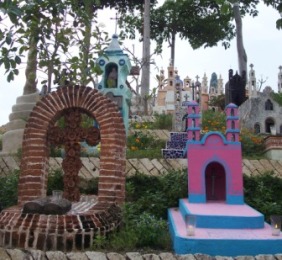by Rachel Ramirez
Most people are familiar with the festival Day of the Dead, especially the images associated with it: sugar skulls, Mexican marigolds, calacas (skeletons) and colorful altars with ofrendas (offerings). Then there are the two days that follow: All Saints Day and All Souls Day. Yet are these two days interchangeable with Day of the Dead or distinct on their own? Here is a brief overview and history of these three distinct days.
Day of the Dead
The observance of Day of the Dead (Dia de los Muertos) began approximately 3000 years ago by the Aztecs and other Meso-Americans and the original observance month was the ninth month of the Aztec Solar calendar, or approximately the month of August. The observance of the dead was a month-long festival and the festivities were presided over by the goddess Mictecacihuatl, who is believed to have died at birth. To the Aztecs and Meso-Americans death was viewed as a continuation and not the end of life, with the belief that life is a dream and to die is to fully awaken. Once the Spaniards conquered the Central and South Americas, they declared Day of the Dead a pagan ritual and believed that the Meso-Americans were making a mockery out of death. Thus, when the Spaniards sought to convert the Meso-Americans to Catholicism they moved the observance of Day of the Dead to October 31 so that it would coincide with All Saints Day and All Souls Day.
All Saints Day
All Saints Day is also known as All Hallows or Hallowmas, honors both known and unknown saints and is observed on November 1. The original observance of All Saints Day began on May 13, either in the year 609 or 610 A.D. by Pope Boniface IV. However, the current date of November 1 started with Pope Gregory III approximately the year 731 or 741 A.D. All Saints Day is observed not only in Latin American countries, but in various European countries, includingPortugal,Spain,Italy,Austria,BelgiumandHungary, and in Catholic parts ofGermany,PolandandRomania, with each country following the Day of the Dead tradition of ofrendas. All Saints Day also coincides with the Mexican observance called Dia de los Innocentes, which honors and remembers deceased infants and children.
All Souls Day
All Souls Day is also known as the Feast of All Souls and occurs the day after All Saints Day, November 2. All Souls Day is meant to commemorate the faithfully departed who have not yet been purified and are in purgatory, thus prayers are repeated so that the souls may enter heaven. The date of November 2 was established by Saint Odio ofClunyin 998 A.D.
Rachel Ramirez has written for Modern Latina since 2006, in addition to Carefair.com. Many of her articles reflect her interest and specialty in skin, beauty, and nutrition. Rachel received her Bachelor’s degree in Nutrition from San Jose State University and currently is a skincare expert with Sephora.

